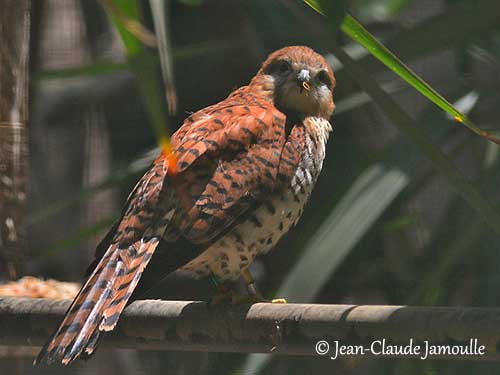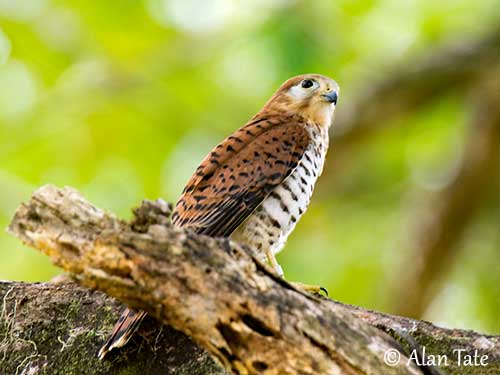
Fr: Crécerelle de Maurice
Ang: Mauritius Kestrel
All: Mauritiusfalke
Esp: Cernícalo de la Mauricio
Ita: Gheppio di Mauritius
Nd: Mauritiustorenvalk
Sd: mauritiusfalk
Photographers:
Jean Michel Fenerole
Photos d’Oiseaux du monde
Jean-Claude Jamoulle
A la rencontre des Oiseaux
Dubi Shapiro
Dubi Shapiro Photo Galleries & Dubi Shapiro's Pictures on IBC
Alan & Ann Tate
AA Bird Photography
Text by Nicole Bouglouan
Sources:
HANDBOOK OF THE BIRDS OF THE WORLD Vol 2 by Josep del Hoyo-Andrew Elliot-Jordi Sargatal - Lynx Edicions - ISBN: 8487334156
BIRDS OF PREY OF AFRICA AND ITS ISLANDS by Alan and Meg Kemp - Struik Publishers - ISBN: 1770073698
The Mauritian Wildlife Foundation (MWF)
Durrell Wildlife Conservation Trust - Saving species from extinction
The Peregrine Fund – World Centre for Birds of Prey
Global Raptor Information Network - Working to Conserve Birds of Prey in nature
The Zoological Society of London - Mauritius kestrel recovery program
Animal Diversity Web (University of Michigan Museum of Zoology)
CEMEX Nature Series volume BACK FROM THE BRINK (2017)
Wikipedia, the free encyclopaedia
Mauritius Kestrel
Falco punctatus
Falconiformes Order – Falconidae Family
INTRODUCTION:
The Mauritius Kestrel is endemic to the forests of Mauritius Island where it has restricted range. It is a small, plump, short-winged kestrel.
It feeds mainly on arboreal geckos, small birds and rodents, and various insects. It typically hunts from perch, in flight or on the ground. This species nests in natural cavities, but it also uses nest boxes. They are monogamous.
The Mauritius Kestrel is primarily threatened by deforestation, with only 2-3% of native forest now remaining. But more recent declines could be related to the use of pesticides in the 1950s and 1960s in agriculture. Introduced predators eat the eggs and kill both adult and young kestrels.
Conservation management of wild populations and reintroduction of captive-reared birds involved some recovery of the population in late 1990s. But habitat destruction and invasion by exotic plants species affect the hunting areas of this kestrel.
The Mauritius Kestrel is currently classified as Endangered. It is the only extant bird of prey on Mauritius.

DESCRIPTION OF THE BIRD:
Biometrics:
Length: 25-29 cm
Wingspan: 49-56 cm
Weight: M: 123-178 g – F: 173-231 g
The Mauritius Kestrel has rufous upperparts with black barring and spotting on mantle and wings, and black streaking on the head. On the upperwing, primary coverts and flight-feathers are dark with rufous spots. The long tail is rufous and regularly barred black, with narrow, white terminal band.
The underparts are whitish with black streaking on upper breast, and mostly black spots and chevrons on lower breast and belly. The underwing is whitish with dark spots on wing-coverts and pale brown barring on flight-feathers. The undertail is whitish with blackish barring.
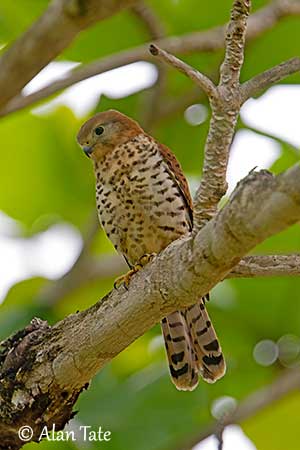
On the head, crown, nape and hindneck are rufous with fine black streaking. The face is white, including eye area, ear-coverts and chin.
The hooked bill is black with yellow cere. The eyes are dark brown, surrounded by bare, yellow skin. Legs and feet are yellow with black claws.
Male and female have similar plumage, but the female is larger and heavier than male.
The juvenile has blue-grey facial skin, becoming yellow through the first year.
RANGE:
The Mauritius Kestrel occurs on Mauritius Island, mainly in SW.
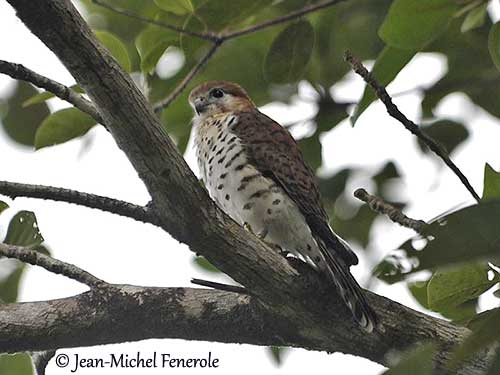
HABITAT:
The Mauritius Kestrel is restricted to the SW forests, cliffs and ravines. It is now adapted to rocky forests and adjacent scrubby areas. It was formerly present in evergreen forest from sea-level to 800 metres of elevation, but there is today only a small remnant patch in SW Mauritius. It does not frequent cultivated areas.
CALLS AND SONGS: SOUNDS BY XENO-CANTO
The Mauritius Kestrel gives a repeated whining call “kreeeh” generally used as contact call. We can also hear a faster chatter of plaintive notes and a sharp “chip”.
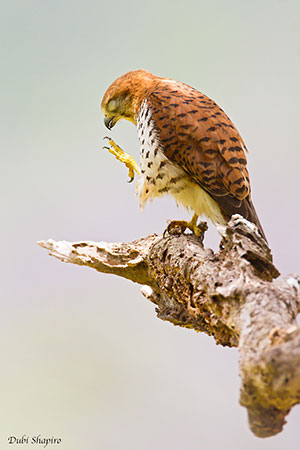
BEHAVIOUR IN THE WILD:
The Mauritius Kestrel feeds primarily on arboreal geckos, but birds, both adults and young, small rodents and insects are also part of its diet.
It hunts from perch from which it performs short, fast strikes onto branches and into foliage, but also along the ground.
It may soar over the canopy but it hovers above more open habitats. Insects are caught in flight. On the ground, it pursues the prey by running and hoping through the vegetation. This kestrel is often solitary.
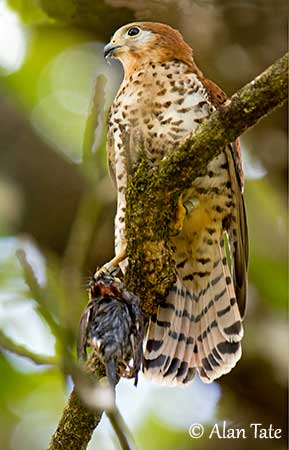
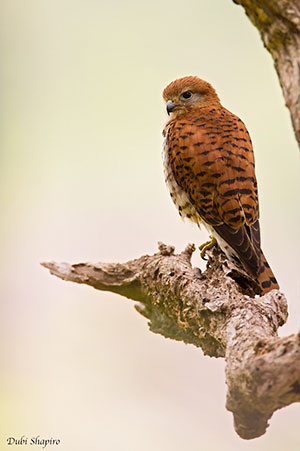
The Mauritius Kestrel is monogamous. It nests in natural cavities in trees or rocks, especially in holes in cliff faces. However, following the recent introduction of nest boxes, it also uses them for nesting.
The Mauritius Kestrel is sedentary, but the young perform short-distance movements.
This species may sometimes glide and soar low over the canopy. It also hovers and makes aerial chases while hunting.
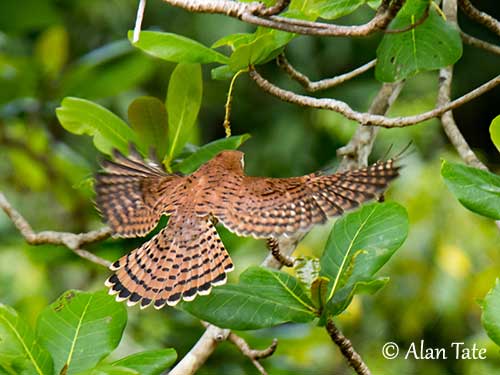
REPRODUCTION OF THIS SPECIES:
The laying takes place between August and November. The Mauritius Kestrel nests in natural cavities such as holes in trees or in rocky cliff faces. But recently, it adapted to artificial nest boxes.
The female lays 4-5, usually 3 whitish eggs with dark brown markings. The incubation lasts one month. The young fledge about 35 days after hatching. They usually remain in their native territory until the next breeding season.
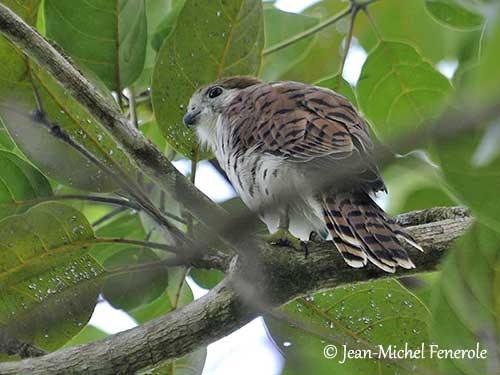
PROTECTION / THREATS / STATUS:
The decline of the Mauritius Kestrel was caused by the use of pesticide (DDT – Dichlorodiphenyltrichloroethane) in the 1940s and 1950s, but this species was rare and limited only to some nest-sites. By the 1980s, the DDT has been abandoned, but deforestation involving fragmented suitable habitats was an important threat for these birds.
Following captive-rearing programme, human-reared kestrels were introduced in the wild. They immediately used the nest boxes between 1984 and 1994.
In 2011-2012, the population was estimated at 250/300 mature individuals, and in 2013 at 170/200 mature individuals. The population trend is assumed to be negative.
In addition, introduced predators such as rats, macaques, Indian mongooses and feral cats are another important threat for eggs, adults and juveniles.
Conservation actions are underway, but currently, the Mauritius Kestrel is classified as Endangered.
